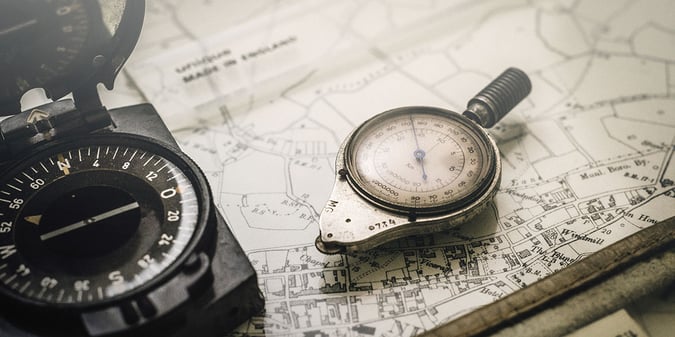
At any given time, museum visitors only see 10% of a museum collection. When I was working at the Smithsonian, I believe the statistic was even lower—a whopping 1% of collection materials were on display! Now consider the possibility of a related but differently categorized collection – that of the museum’s archives. Archival materials rarely make it onto the museum’s exhibition floor and yet they are critically important to correctly interpreting the museum’s objects.
The museum-archive relationship can be difficult to typify; every institution is different. However, there are universal markers to the museum-archive dynamic and we’ll explore them in this post.
As discussed in a previous post, The Intersection of Libraries, Archives & Museums, Libraries, Archives, and Museums (LAMs) exist in silos due to a couple of key differences in the format and use of their collections:
The items are in different formats:
- Libraries have reference materials in the form of bound materials
- Archives have primary research documentation, often 2D
- Museums have art or historical objects, typically 3D
The items are for different uses:
- Library items are used for reference
- Archival items are used to contextualize museum objects
- Museum items are displayed and used to understand the culture and time period the object came from
Furthermore, there are different national and international standards for describing each collection, and only recently can collections management systems catalog and display all three library, archive, and museum item types together. The library’s connection with its counterparts continues to be worthy of discussion, but the museum-archives relationship is a harder one to understand and navigate.
Acknowledging differences
The unbalanced museum-archive relationship can be seen in a typical museum setup. A museum organization houses multiple departments dedicated to the care, management, and display of museum objects. In contrast, only one department is focused on the care, management, and accessibility of archival items. The items are often physically separated and may not even be presented together via a digital platform. Museum policy, funding, and planning decisions are usually made without the equal participation of the archives. What is often neglected in these traditional museum setups is the informative relationship that exists between the collections of the museum and archives. Archival collections can and should be used to provide additional contextual information to a museum’s object collection. Valuable insight and deep research opportunities are available in every museum’s archives. It’s a truth that is barely acknowledged and too frequently dismissed when it comes to organization activities outside of research.
Shared history
The operation of museums and archives can seem quite separate today, but they actually share ancient origins dating back to 2nd millennium BCE. Temples of Babylonian kings have been found by archaeologists to contain antiquities (museum objects) and clay tablet inscriptions (archival documents). The instinct to document the past and present by collecting items existed in this ancient era. However, through the millennia, it’s not a wide-spread inclination we see again until much, much later.
Museums and archives reemerged contemporaneously at the beginning of the 18th century. The first modern European museum was the British Museum (1753) and it was established alongside many European contemporaries. The current concept of archives originated from the establishment of France's Archives Nationales (1789) and Archives Départementales (1796). Both were established after the end of France's Revolutionary War.
Separate paths
Despite the concurrent evolution of museums and archives, their establishment as modern-day professions occurred separately. Informal analysis of coursework and degrees offered for museologists show the development of the profession beginning in the early 20th century. Meanwhile, the professionalization and education track for archivists began in the late 1930s and wasn’t significantly established until the 1970s.
The professional separation was further solidified by the insistence that museums and archives remain detached because museums collect 3D objects for display, and archives collect 2D documentation for research. The lack of literature available on this divide, which is superficially based on format and use, to me indicates past professionals didn’t see the value in honoring the relationship between the two collections.
Integrated purpose
Museums and archives are just beginning to explore a closer relationship. In the last 10-20 years there has been a quietly growing sentiment in both camps that collections, practices, and principles should be more integrated. From a common-sense perspective, there is no reason why collections should be physically separate for storage since they both (usually) have the same storage preservation requirements. Additionally, it makes no sense to display a museum object without the accompaniment of the archival documents used to inform the contextual research of an object in preparation for its display.
Thanks in part to the advent of comprehensive collections management systems, professionals in museums and archives are beginning to rectify the exclusive way their collections, practices, and principles operate. They acknowledge the general public’s expectation to see collections together regardless of whether something is a museum or archival item. As a result, professionals from both entities are implementing collections management systems that can incorporate items from any repository, despite separate cataloging practices.
The need for equality
Items can now be displayed together digitally but are rarely displayed together physically within a museum. This is indicative of the pervasive and problematic thinking that museum collections should receive top consideration when it comes to the management and running of the museum organization. Too often in my career I’ve seen archives (and libraries) relegated to the proverbial sidelines as museum policy, funding, and planning decisions were made with the sole focus of how it supported the museum collections. The lack of consideration for the archives is present in every strategic plan, fundraising initiative, and exhibition display that has little to no mention of how the archival collections bring added value to the museum’s objects. This can be a contentious issue, with many museum professionals choosing not to engage their archival colleagues, and many archives professionals feeling defeated and excluded. The unhealthy relationship isn’t good for the professionals who work there, and it ultimately isn’t good for the stewardship of the collections and the people who enjoy them.
Relationship evolution
Despite the work still ahead of us, it is undeniable museums and archives are headed towards a closer working relationship. The momentum may have started with the opportunity provided by collections management systems, but I believe integration can go so much deeper. If practices and principles can be looked at from a broader view, many will see the differences between museums and archives are miniscule. I advocate for museums and archives to proactively engage in this relationship evolution so they can come closer to achieving a holistic approach to managing, understanding, and displaying collections.


